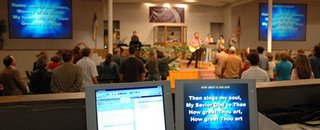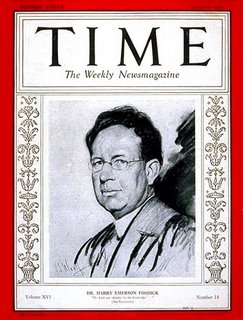 I’m not going to preach about cancer. I don’t want cancer to define me as a preacher during this season of my illness – although, as I stand up there with my nearly-bald head, I’ll be under no illusions that my listeners won’t be thinking about it. But so what? As ol’ Popeye used to say, “I yam what I yam, and that’s all that I yam.”
I’m not going to preach about cancer. I don’t want cancer to define me as a preacher during this season of my illness – although, as I stand up there with my nearly-bald head, I’ll be under no illusions that my listeners won’t be thinking about it. But so what? As ol’ Popeye used to say, “I yam what I yam, and that’s all that I yam.”I’m going to speak, instead, about mission. I’m concerned about some tendencies I see, both in our local church and in the larger Presbyterian Church, to hunker down and focus most of our resources locally in these times of financial strictures. We’re in danger of becoming parochial. There’s an increase in the sort of thinking that used to be a problem in the eighteenth and early nineteenth centuries, back when parishioners used to rent their pews through an annual subscription. When it came time to appeal for offerings for roof repairs, the snappy response is said to have come back, “Why should I give? It’s not raining over my pew!”
Anyway, I’m thinking it’s time for a gentle reminder that the church is bigger than the lot on which its building sits, and the church’s mission is larger than simply opening the doors and inviting people to come in.
Sometimes, raising topics like that as a traditional preacher, I feel a bit like a dinosaur. When I was in seminary, there were some who were eagerly writing the obituary of the traditional sermon. We were all being encouraged to preach first-person sermons (dramatic monologues in which we took on the role of a biblical character) or dialogue sermons (a sort of ecclesiastical tag team involving two preachers). Thankfully, those innovations never really took hold. In seminaries today, they’re still saying the traditional sermon is on life-support, but they’re encouraging us preachers, instead, to wire our sanctuaries for light and sound, and accompany our talks with Power Point presentations and video clips. This is in order to reach the younger generations who are more visual, and have supposedly lost the ability to sit and listen to anything longer than the interval of time between TV commercials, unless they also have something to look at.

I don’t think we’ll ever return to the days when people used to line up around the block to hear Harry Emerson Fosdick preach forty-minute sermons, or when the major newspapers used to run Monday-morning summaries of the previous day’s pulpiteering. But I wouldn’t want to mutter “ashes to ashes, dust to dust” over the traditional sermon, either. It’s proven remarkably durable over the years, despite each generation’s attempt to replace it with something else.
 Yesterday’s New York Times had a couple of articles that got me to thinking about this whole business of preaching. One article notes that Protestant theological seminaries continue to be filled with students, but that (1) these are mostly mature students, and (2) comparatively few of the younger students are interested in becoming pastors of churches after they graduate. (This is nothing new to me; I could see these trends beginning more than fifteen years ago, back when I was a seminary admissions director – but it seems somehow significant that the Times has discovered these factoids and deemed them worthy of publication.) The second article, from the same issue of the same newspaper, focuses on how the spoken word is becoming trendy again, and how public lectures on a variety of topics are becoming some of the hottest tickets in the Big Apple (Neela Banerjee, “Students Flock to Seminaries, but Fewer See Pulpit in Future,” and Dinitia Smith, “In the Age of the Overamplified, a Resurgence for the Humble Lecture,” both articles in the New York Times, March 17, 2006).
Yesterday’s New York Times had a couple of articles that got me to thinking about this whole business of preaching. One article notes that Protestant theological seminaries continue to be filled with students, but that (1) these are mostly mature students, and (2) comparatively few of the younger students are interested in becoming pastors of churches after they graduate. (This is nothing new to me; I could see these trends beginning more than fifteen years ago, back when I was a seminary admissions director – but it seems somehow significant that the Times has discovered these factoids and deemed them worthy of publication.) The second article, from the same issue of the same newspaper, focuses on how the spoken word is becoming trendy again, and how public lectures on a variety of topics are becoming some of the hottest tickets in the Big Apple (Neela Banerjee, “Students Flock to Seminaries, but Fewer See Pulpit in Future,” and Dinitia Smith, “In the Age of the Overamplified, a Resurgence for the Humble Lecture,” both articles in the New York Times, March 17, 2006).If there’s anything to this trend of rejecting high-tech glitz and returning to the simplicity of the talking head, then perhaps the churches that are so eagerly jumping on the bandwagon of rear-projection screens and computer animations have hurled themselves into a Keystone Cops car that’s careening off in precisely the wrong direction. For who has been offering “the humble lecture” longer than Protestant preachers? (I’d like to think we do it well, but that’s for our listeners to decide.) Far be it for the Times writer to think in such terms, however; her range of vision is limited to public library and museum programs.
 I still think there’s a place for the traditional sermon in our wired world. There’s something real, and authentically human, about people talking to other people, with no more electronic assistance than perhaps a microphone. Garrison Keillor has reminded us, through thirty years of immensely popular Prairie Home Companion broadcasts, that radio can still be more than either an endless parade of vacuous top-40 tunes or a killing field for victims of right-wing talk-radio hosts. His Lake Wobegon tales teach us there’s still such a thing as the human imagination, and that it can be accessed through the ears as well as the eyes.
I still think there’s a place for the traditional sermon in our wired world. There’s something real, and authentically human, about people talking to other people, with no more electronic assistance than perhaps a microphone. Garrison Keillor has reminded us, through thirty years of immensely popular Prairie Home Companion broadcasts, that radio can still be more than either an endless parade of vacuous top-40 tunes or a killing field for victims of right-wing talk-radio hosts. His Lake Wobegon tales teach us there’s still such a thing as the human imagination, and that it can be accessed through the ears as well as the eyes.So, enough blogging for today. Off I go to write the sermon...
3 comments:
Well, how did it go?
I've been thinking about you a lot, and hope to call you soon.
bc
Well, how did it go?
I've been thinking about you a lot, and hope to call you soon.
bc
Bill,
If you're talking about the CT scan results, I still haven't heard yet. There was a problem locating the films from my earlier CT scan, somewhere between Sloan-Kettering and Ocean Medical Center. Sloan appparently found the films (which they hadn't returned to me along with the other diagnostic test results) - or at least they found some record of the films - and said they'd send them to me, but they haven't arrived. I'm going to phone them again today, and see what happened.
The radiologist wanted the earlier films, for comparison purposes. I suppose they could use the PET scan results, but they may want to compare apples to apples.
I see Dr. Lerner (my oncologist) on Wednesday, when I go in for my next treatment, so maybe I'll find something out then.
Post a Comment